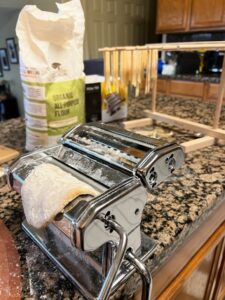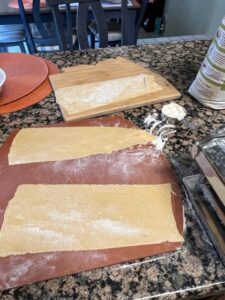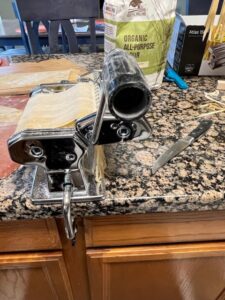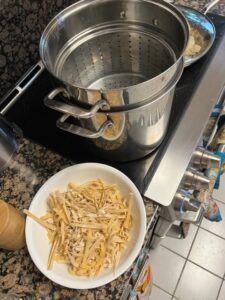 I had much better luck with making the sprouted grain Fettucini with the pasta roller than making sprouted grain spaghetti with the pasta extruder.
I had much better luck with making the sprouted grain Fettucini with the pasta roller than making sprouted grain spaghetti with the pasta extruder.
Making the Pasta Dough
2 eggs, 1/2 cup sprouted kamut flour, 1/2 cup sprouted soft white wheat flour, 1/4 tsp salt, 1/2 cup organic white flour to keep the dough from sticking – makes four servings.
Using a shallow wide bowl, first mix the eggs, salt, and sprouted flours together with a fork. Then knead it into a ball with your hands. If the dough is sticky, work in the organic white flour 1 teaspoon at a time until the dough is no longer sticky.
Cover the pasta dough ball with saran wrap and let it rest for an hour and a half to give the flour time to absorb the moisture from the egg.
Making the Fettuccini
With this quantity of dough, it helps to cut it into four equal sections and do these steps for each section of dough, completing all the way through cutting the linguini before starting on the next section.
 Step 1 – strengthen the dough – this step is difficult to do with the pasta extruder but is what the pasta roller is designed to do.
Step 1 – strengthen the dough – this step is difficult to do with the pasta extruder but is what the pasta roller is designed to do.
a. Put a tablespoon of the organic white flour on a cutting board and flatten out 1/4 of the dough in the flour and make sure it’s not sticky.
b. Roll the flattened dough through the pasta roller on the widest setting (0 on my pasta roller)
c. Dust the flattened dough with more flour, fold over and roll through the pasta roller again on the widest setting. Repeat at least ten more times. This helps to strengthen the dough so you can make the light, thin fettuccini.
Step 2 – create paper thin dough sheets
a. Once the dough is not sticky, and thick, then you start making it thinner. The roller has a dial you can move one number at a  time – the higher the number the more thin the dough sheet. For the fettuccini, the dough sheet should be at the 6 or 7 level of thinness. If the dough has good structural integrity, you can get it thin at the 7 level of thinness. If the dough sheet is getting shreds in it, you dial it back to the level thickness where it was not getting shredded. For example – when I took the dough sheet to the 8 level, it was shredding so I brought it back to the level 7. After each roll of the dough sheet through the rollers, dust the dough sheet, and then decrease the roller thicknesses one level at a time, dusting the dough sheet with flour over each pass through the rollers.
time – the higher the number the more thin the dough sheet. For the fettuccini, the dough sheet should be at the 6 or 7 level of thinness. If the dough has good structural integrity, you can get it thin at the 7 level of thinness. If the dough sheet is getting shreds in it, you dial it back to the level thickness where it was not getting shredded. For example – when I took the dough sheet to the 8 level, it was shredding so I brought it back to the level 7. After each roll of the dough sheet through the rollers, dust the dough sheet, and then decrease the roller thicknesses one level at a time, dusting the dough sheet with flour over each pass through the rollers.
b. By the time you get to level 4, the dough sheet starts to get long. Once the dough sheet gets to be 12 inches which happens around level 4, cut it in half. At level 6, you have to cut the dough sheet in half again.
c. At level 7, the dough sheet will be about 12 inches, if you have been cutting it in half at the 4 and 6 levels. Make sure you dust both sides with flour.
 Step 3 – cut the dough sheets into fettuccini
Step 3 – cut the dough sheets into fettuccini
a. The pasta roller I use has a flat noodle cutting attachment. The thickness of the dough determines the type of noodle.
b, I have better luck keeping the noodles from breaking by hanging it over either the side of a deep pan or on the pasta drying rack.
c. Some of the noodles will fall off the drying rack. Toss this with flour to keep it from sticking.
d. You can also cut the dough sheets with a knife to make your own fettuccini or wider pasta noodles.
e. If you are going to save the noodles to cook later, let it dry about an hour, then put it in a zip lock bag and freeze it until you are ready to use.
Cooking the Fettuccini
 Boil several quarts of salted water in a large pasta pot (you want to have at least 2 times more water than pasta so your pasta has plenty of room to move and does not clump together). Taste the water and it should be as salty as the ocean – you may need to add in several tablespoons of salt to get to this level of saltiness.
Boil several quarts of salted water in a large pasta pot (you want to have at least 2 times more water than pasta so your pasta has plenty of room to move and does not clump together). Taste the water and it should be as salty as the ocean – you may need to add in several tablespoons of salt to get to this level of saltiness.
Combine the dried fettuccini in a bowl and dust with more flour to keep it from sticking together. Wipe the bowl clean as you will be putting the cooked pasta back into this bowl.
Add the dusted noodles into boiling water and stir for the 3 – 4 minutes it takes to cook. Test it out and remove it when it is “al dente.”
Strain the fettuccini out of the water and put it back in the bowl it was in before you put it in the pot.
Toss in several tablespoons of butter and mix to coat the noodles – it helps to keep the them from sticking.
Mix in 1/2 cup of shredded parmesan cheese. Top with fresh ground black pepper.
Enjoying the Fettuccini

This fettuccini gets center stage on its own. It’s delicate, soft, and delicious (not gritty at all as other sprouted grain pasta efforts have been before this experiment blending the sprouted kamut and soft white wheat).
I made a lemon garlic chicken with mushrooms in a lemon, butter and white wine sauce to go with the fettuccini.
To plate, I place the pan sauce first. Then put the chicken and fettuccini on top of the pan sauce. I brightened up the plate with wedges of a beautiful heirloom tomato. By putting the pan sauce on the plate first, you can enjoy the noodles on it’s own and with the sauce as well.

